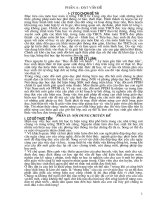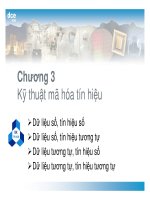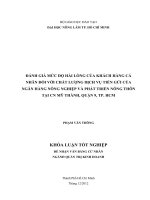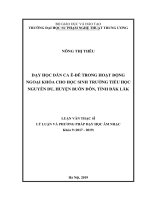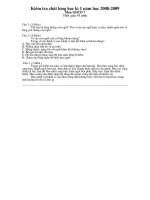D ISTANCE EDUCATION AT M ARYLAND C OLLEGES AND U NIVERSITIES C ALENDAR YEAR 2011 DECEMBER 2012 MARYLAND HIGHER EDUCATION COMMISSION 6 NORTH LIBERTY STREET TENTH FLOOR BALTIMORE, MD 21201
Bạn đang xem bản rút gọn của tài liệu. Xem và tải ngay bản đầy đủ của tài liệu tại đây (439.2 KB, 25 trang )
<span class="text_page_counter">Trang 1</span><div class="page_container" data-page="1">
<b>DISTANCE EDUCATION</b>
<b>CALENDAR YEAR 2011 </b>
<b>December 2012 </b>
</div><span class="text_page_counter">Trang 2</span><div class="page_container" data-page="2">Anwer Hasan, Chairman Sandra L. Jimenez, Vice-Chair <b>Secretary of Higher Education </b>
</div><span class="text_page_counter">Trang 3</span><div class="page_container" data-page="3"><b>Table of Contents </b>
Introduction……….………….1
Survey and Methods……….………...……..…..1
Background and Definitions……….……...……..…..1
Summary of Key Findings………...……..…..3
Detailed Survey Findings………..………...4
I. Unduplicated Course Count……….………….………..…..4
II. Duplicated Counts: Courses, Sections, & Enrollments………...………….7
Courses (by term)………...7
Sections……….…..…....8
Enrollments………11
III. Unduplicated Student Headcount………..………..…14
IV. Student Credit Hours……….………….……….16
V. Credit-Bearing Programs Offered Entirely by Distance Education………...………...18
VI. Non-Credit Activity Measures………..………...………18
New Areas of Research………….………...………...………...19
Implications for Policy and Practice………...………...20
Appendix A: Maryland Higher Education Institutions (Fall 2011)………...……21
</div><span class="text_page_counter">Trang 4</span><div class="page_container" data-page="4">INTRODUCTION
Maryland’s postsecondary colleges and universities serve more than 370,000 students and enrollments are expected to increase in the coming years. To support the educational needs of an
<i>increasingly diverse student body, the 2009 Maryland State Plan for Postsecondary Education </i>
recommends that distance learning be considered as an integral strategy for expanding program offerings to more Maryland residents.
MHEC has been examining trends in distance learning since 1997. This report analyzes data from Calendar Year 2011, but also highlights changes in DE activities since Calendar Year 2008. Data included in this report are derived from MHEC’s 2011 Distance Education Survey and from MHEC’s 2008 Distance Education Survey and Report.
Survey and Methods
The Distance Education (DE) Survey was created to inform the Maryland Higher Education Commission (MHEC) of postsecondary institutions’ progress toward enhancing electronically delivered instruction on their campuses. In fall 2006, the DE Survey was redesigned to align it with the data requirements of the Southern Regional Education Board’s (SREB) annual survey and to reduce duplicative reporting requirements for institutions. The Distance Education Survey for calendar year 2011 included five mandatory questions and two follow-up questions.
Institutions were asked to fill in tables regarding duplicated and unduplicated DE courses, sections, credit hours, and enrollment. The tables disaggregated the data by student level, term, and type of delivery. Finally, the survey asked institutions to list, if any, the programs they offer entirely online. Each table in the survey roughly corresponds to a section in the Detailed Survey Findings chapter of this report. Fifty-seven institutions, including community colleges, public four-year institutions, and independent institutions in the State of Maryland responded to survey sent out in spring 2012, which asked about courses taught during the 2011 calendar year. A listing of the institutions that participated in the DE Survey appears in Appendix A.
Background and Definitions
Distance education (DE) aims to deliver instruction to students who are not physically present in the same location as the course instructor. The Maryland Higher Education Commission
(MHEC) defines distance education courses as classes in which at least 50% of the course instruction/interaction was conducted via distance learning technologies Technology is the primary mode of instruction/interaction in DE. Comparatively, traditional courses have more than 50% of their instruction/interaction in a traditional classroom or face-to-face setting, with specified meeting times and standard locations. DE courses are not web-enhanced courses, which are defined as those that have standard meeting places/times but include an electronic
component, such as electronic delivery of homework assignments. Web-enhanced courses may also allow e-mail exchanges between instructors and students using Learning Management System (LMS) solutions such as WebCT or Blackboard. In addition, DE courses do not include traditional correspondence courses.
</div><span class="text_page_counter">Trang 5</span><div class="page_container" data-page="5">There are three types of DE delivery methods defined in the 2011 MHEC Survey: (1) Online & Blended Hybrid; (2) Site-to-Site, 2-way Audio/Video; and (3) all other technology-mediated distance education. Online courses are delivered via the internet while Blended Hybrid courses include scheduled face-to-face sessions, although less than 50% of the scheduled interaction occurs in this manner. Site-to-Site, 2-way Audio/Video courses are delivered at special facilities that allow students to connect to remote classrooms via transmission equipment. Other
technology-mediated DE methods include courses taught by closed-circuit, broadcast radio, and tele-courses (both live and pre-recorded).
All community colleges, public four-year institutions, and independent institutions were asked to complete the Maryland Higher Education Commission’s DE Survey as a part of the Maryland Annual Collection process. The DE Survey covers four topic areas: (1) unduplicated course counts; (2) duplicated distance courses, sections, and enrollments; (3) calendar year student credit hours; and (4) unduplicated student headcount enrollments. Unduplicated course counts tabulate each unique course title only once for 2011, even if the same title was offered in multiple semesters during the reporting period or via multiple distance delivery methods. Duplicated counts of courses, sections, and enrollments include all such instances, even if the same course or student is counted multiple times during the same term or year. Calendar year credit hours count the number of credit hours earned from January through December of 2011. In this report, “enrollment” (or headcount) represents the number of students who register for course sections. This is a duplicated headcount, meaning students who register for multiple courses during the same semester or during the same calendar year will be counted more than once. For example, a student who enrolls in five DE courses may count as five DE enrollments. In this report, “unduplicated student headcount” counts each student only once during the specified time period, regardless of how many distance education courses he or she took. Alternatively, duplicated student headcounts count course registrations, and so may count the same student multiple times. Enrollment is reported by student level, and not the level of the course for which the student was enrolled. For example, a graduate student enrolled in an undergraduate course is reported as a graduate student, even if the student only enrolled in
<i>undergraduate courses during 2011. Only courses that were offered and taught (i.e. not canceled </i>
before they begin) are included in this report. If a course had multiple sections, some of which were offered DE and some of which were the traditional face-to-face format, only the DE sections are included in the analysis of DE sections.
Statistics for the University of Maryland, University College (UMUC) are often listed separately from other public four-year institutions. UMUC is an outlier in that nearly all of its students enroll exclusively in DE courses. When analyzing the total number of unduplicated DE courses taught, this analysis replaces Montgomery College’s 2008 calendar year data with data from the 2009 calendar year. This is due to what appears to be a one-year statistical aberration in
Montgomery College’s survey response for 2008.
</div><span class="text_page_counter">Trang 6</span><div class="page_container" data-page="6">Summary of Key Findings
<i>Access and Enrollment </i>
DE course offerings and DE enrollment grew rapidly between 2008 and 2011. Of the 57 institutions responding to the survey, 43 (75%) offered DE courses. Among public four-year institutions, St. Mary’s College of Maryland is the only institution that did not offer any DE courses. An examination of the number of DE courses offered during calendar years 2008 and 2011 indicates growth in DE access and enrollment. Total enrollments in DE courses grew from 284,030 in 2008 to 442,105 in 2011, a 56% increase. In 2008, 11% of undergraduates and 26% of graduate students were enrolled exclusively in courses delivered via DE. By 2011, these percentages had increased to 13% and 29%, respectively.
<i>UMUC is an Outlier </i>
While most institutions have adopted DE, none offer as many DE courses as the University of Maryland, University College. UMUC is an outlier in distance education. Of all credits earned at UMUC in 2011, 91% of undergraduate credits and 98% of graduate credits were DE. Ninety-five percent of undergraduates and 99% of graduate students enrolled in at least one DE course at UMUC. Among other public four-year institutions, 22% of undergraduates and 20% of graduate students enrolled in at least one DE course.
<i>Variation Across Segments and Student Level </i>
DE is not monolithic; there is variation in DE offerings and enrollments across segments and student level. Delivery method and the percentage of students who enroll in distance education courses differ from segment to segment. Among undergraduates, 29% of community college students, 21% of public four-year (non-UMUC) students, and 10% of independent college students enrolled in at least one DE course. Fifteen percent of earned credit hours at community colleges were DE in 2011. Among public four-year institutions (excluding UMUC), five percent of undergraduate earned credit hours were DE. Among independent colleges, that figure was two percent. Approximately 99% of all undergraduate DE courses in the public sector were Online & Blended Hybrid. Eighty-five percent of undergraduate DE courses at independent institutions were Online & Blended Hybrid, while another 15% were Site-to-Site.
There was also variation between undergraduate and graduate DE students. Graduate students were more likely than undergraduates to enroll in one or more DE courses. Graduates were also more likely to take course loads that were entirely DE. In other words, graduates were less likely to enroll in at least one traditional course at some point during the year.
It is unclear whether these differences in DE enrollment across segment and student level were the result of student demographics; peculiarities unique to certain institutions, segments, or student level; or some other variable or variables. It is equally unclear what, if any, impact these differences will have on higher education in Maryland. The causes and effects of these variations may become more evident as DE continues to grow.
</div><span class="text_page_counter">Trang 7</span><div class="page_container" data-page="7">DETAILED SURVEY FINDINGS
The findings from MHEC’s Distance Education (DE) Survey are presented in the following four sections: (1) unduplicated course counts; (2) distance courses, sections, and enrollments; (3) calendar year student credit hours; and (4) unduplicated student headcount enrollments.
I. Unduplicated Course Count
In 2011, Maryland colleges and universities offered 6,308 unduplicated DE credit-bearing courses, an increase of 47% over 2008, as shown in Figure 1. The number of DE courses offered at both the
undergraduate and graduate levels increased by 47%. Seventy-one percent (or 4,483 courses) of the 6,308 DE credit courses offered at Maryland colleges and universities in 2011 were at the undergraduate level.
As shown in Figure 2, both graduate and undergraduate levels in every segment increased the number of DE courses taught from 2008 to 2011. The public segments – community colleges, public four-year undergraduates, and public four-year graduates – offered more DE courses than independent institutions and added more over the three years. At 2,606, community
colleges offered the most DE courses in 2011, and added the most courses (715). The next largest increase was among public four-year undergraduate DE courses, which increased by 548. However, independent institutions grew faster than public segments during the three-year period. This may be due to the overall smaller size of the
independent segment when compared to the size of the public institutions. Independent
undergraduate courses increased by 94% and graduate courses increased by 80%. DE courses at community colleges grew by 38%, while undergraduate and graduate courses at public four-year institutions increased by 56% and 33%, respectively.
</div><span class="text_page_counter">Trang 8</span><div class="page_container" data-page="8">Figure 3 shows that community colleges offered a smaller share of total
undergraduate DE credit courses in 2011 compared to 2008. In 2011, the percentage of all undergraduate DE courses offered at the community colleges was 58% (down from 62%), while public four-year institutions offered 34% of the total (up from 32%), and independent institutions taught eight percent (up from six percent). The total number of DE graduate courses increased from 1,244 to 1,825 over the three-year period.
<i>Community Colleges </i>
The unduplicated number of unique DE courses offered by community colleges during the 2008 and 2011 calendar years is shown in Table 1. Between 2008 and 2011, the number of
undergraduate DE credit courses offered by the community colleges increased by 38%, or 715 courses. Frederick Community College grew the most over this time period, increasing its number of DE courses by 128%. Anne Arundel taught more DE credit courses (396) than any other community college in 2011.
<b><small>Table 1: Unduplicated Distance Education Credit-Bearing Courses at Community Colleges, 2008-2011 </small></b>
</div><span class="text_page_counter">Trang 9</span><div class="page_container" data-page="9"><i>Public Four-Year Institutions </i>
The unduplicated number of unique DE courses at public four-year institutions is presented in Table 2. The number of DE graduate courses offered at the public four-year institutions increased from 877 to 1,166. Only two public four-year institutions reported a decrease in the number of DE graduate courses, and neither dropped more than eight courses. From 2008 to 2011, the number of undergraduate DE credit courses offered by the public four-year institutions increased by 548 courses, or 56%. The University of Maryland, University College (UMUC) offered a total of 915 unduplicated, DE credit-bearing courses – 641 on the undergraduate level and 274 on the graduate level. UMUC accounted for 34% of all DE courses at public four-year institutions. Among the other public four-year institutions, the largest number of DE courses were offered by the University of Maryland-College Park (407) and Towson University (295).
<b><small>Table 2: Unduplicated Distance Education Credit-Bearing Courses at Public Four-Year Institutions, 2008-2011 </small></b>
Table 3 presents the unduplicated number of DE courses offered at independent institutions during the 2008 and 2011 calendar years. The number of undergraduate DE credit courses offered at independent colleges and universities nearly doubled between 2008 and 2011, from 179 to 348.At independent institutions, the number of DE graduate courses offered increased from 367 to 659, or 80%, since 2008. Johns Hopkins University, Stevenson University, and
<i>Capitol College accounted for 57% of the courses offered by the independent segment. </i>
</div><span class="text_page_counter">Trang 10</span><div class="page_container" data-page="10"><b><small>Institutions </small></b> <i><b><small>2008 </small></b></i> <b><small>2011 % Change 2008-2011 </small></b>
<small>* Data not available </small>
<small>**Baltimore Hebrew and Baltimore International participated in the 2008 survey but are no longer independent institutions </small>
II. Duplicated Counts: Courses, Sections, & Enrollments
<i>Courses (by term) </i>
Table 4 contains the distribution of course title offerings, by term, of all courses where at least one section was offered as DE. Some of these courses had all sections taught via DE while some of these courses had only some sections that were DE. If the same course was taught in multiple terms, it is counted in each term it was offered. At the undergraduate and graduate levels, Spring and Fall had the most DE courses (each semester comprised over one third of year-round unique DE courses). The Winter term had the fewest number of DE courses. The Winter term typically has fewer traditional courses than other terms. UMUC does not have a Winter term, which may further contribute to the relatively small number of Winter DE course offerings.
</div><span class="text_page_counter">Trang 11</span><div class="page_container" data-page="11"><b><small>Winter Spring Summer Fall </small></b>
The growth in DE sections by segment and level is shown in Figure 4. There were 23,428 DE sections offered by Maryland colleges and universities in 2011, an increase of 8,602 sections, or 58%, since 2008. The largest increases were at public four-year undergraduates and community colleges, which grew by 3,380 and 2,856 sections, respectively. Seventy-six percent of all DE credit course sections were offered at the undergraduate level. Since 2008, the number of undergraduate sections offered has increased by 6,240 sections. In 2011, community colleges offered 8,768 DE sections, or 37% of all DE sections offered at Maryland universities and colleges.
Public four-year institutions were responsible for 53% of all DE sections offered statewide. In 2011, Maryland colleges and universities offered 5,545 credit-bearing sections at the graduate level, an increase of 59% since 2008.
<i>Community Colleges. Table 5 reports the number of community college DE sections in which at </i>
least one student. Overall, community colleges added nearly 3,000 DE sections since 2008, an
<i>increase of 48%. Allegany and Wor-Wic were the only community colleges to experience </i>
declines in the number of DE course sections. Anne Arundel added the most DE sections, growing by 715. The next biggest increase was at Montgomery (465), which nearly doubled its offerings. Only Harford grew at a faster rate than Montgomery, by increasing its DE sections
</div><span class="text_page_counter">Trang 12</span><div class="page_container" data-page="12"><b><small>Community Colleges 2008 2011 % Change 2008 to 2011 </small></b>
<i>Public Four-Year Institutions. The number of DE sections in which at least one student enrolled </i>
in 2008 and 2011 at a public four-year institution is presented in Table 6. Overall, DE sections rose by 67% at the undergraduate level and 47% at the graduate level. Among public four-year institutions, 70% of all DE sections were offered by the University of Maryland, University College. Towson University offered the second-most number of DE sections, accounting for five percent of all DE sections at public four-year institutions. UMUC also grew by the most number of sections (2,901). The fastest growth rate was at Morgan State, which increased from four DE sections to 124. The University of Maryland, Eastern Shore was the only institution to
<i>experience a decline in any level: its graduate DE sections dropped from five to four. </i>
<b><small>Table 6: Distance Education Course Sections, by Level, 2008 and 2011 </small></b>
</div>